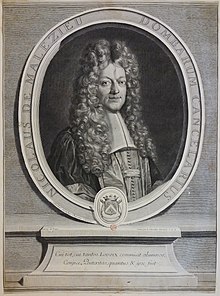Nicolas de Malézieu

Nicolas de Malézieu (or Malézieux)[1] (or Malesieu)[2] (7 September 1650, in Paris – 4 March 1727, in Paris) was a French intellectual, Greek scholar and mathematician.[3]
Life and career
[edit]Nicolas de Malézieu was a squire and lord of Chatenay. He later became chancellor of Dombes and secretary-general to the Swiss and Grisons of France. He was the tutor of Louis Auguste, Duke of Maine (to whom he introduced Bossuet) and he declaimed the plays of Euripides and Sophocles to the duchess who had made her chateau of Sceaux into a literary salon. Here he became a member of the light-hearted fraternity she founded, the (fr) Knights of the Bee, and organised the festivals she loved, the fr:Grandes Nuits de Sceaux. Later tutor to duc de Bourgogne, he was appointed to the Académie royale des sciences in 1699 and to the Académie française in 1701.[4]
Malézieu collected and published the lessons in mathematics that he gave to the duc de Bourgogne over four years in 1705 as Élémens de géométrie de Mgr le duc de Bourgogne. Le Journal des savants reported in detail the observations he made in this work on geometry and infinitely small numbers. In 1713, this work was translated into Latin as Serenissimi Burgundiae Ducis Elementa Geometrica, ex Gallico Semone in Latinum translata ad Usum Seminarii Patavini. A third (posthumous) edition, with corrections and a supplemental treatise on logarithms, appeared 1729.[3]
Nicolas de Malézieu also translated Euripides’ Iphigenia in Tauris as well as poems, songs and sketches, which were published in 1712 in Les Divertissements de Sceaux and in 1725 in the Suite des Divertissements. Among these pieces are Philémon et Baucis, Le Prince de Cathay, Les Importuns de Chatenay, La Grande Nuit de l'éclipse, L'Hôte de Lemnos, La Tarentole[5] and L'Heautontimorumenos. Often written in a single day, these pieces were set to music and staged for the amusement of the duchess, to whom Malézieu also gave courses in astronomy.
A four-volume work, a Histoire des fermes du roi (History of Royal Farms) survives only a manuscript version dating from 1746.[6]
Pierre-Édouard Lémontey said of Malézieu "Knowing a bit about everything, he gathered in his servile person all the advantages of universal mediocrity."[4]
Family
[edit]Malézieu was the son of Nicolas de Malézieu (1612-1652) and Marie des Forges (d.1680).[3] His brother Michel Louis de Malézieu married Marie Jérônime Mac Carthy (d.1714)[7]
In 1672 Malézieu married Françoise Faudel de Fauveresse (1650-1741) by whom he had the following children:[8]
- Nicolas de Malézieu (1674-1748), bishop of Lavaur en 1713.[9]
- Pierre de Malézieu (1680-1756), married Louise Marthe Stoppa in 1717 (d.1720), under-secretary to the duc de Maine, secretary-general of the Swiss and Grisons in 1727, brigadier of the infantry, ifnanterie, maréchal de camp in 1734, lieutenant general of the artillery and commander of the Order of Saint-Louis in 1756.
- Charles-François de Malézieu (d.1763), lieutenant-colonel of a brigade of carabiniers, cavalry brigadier in 1745, governor of the harbour and defences of La Rochelle.
- Élisabeth de Malézieu (b.1676), married (1699) Antoine des Rioux de Missimy, first president of the parlement and intendant of Dombes
- Marie de Malézieu (b.1682), married (1705) Louis de Guiry, seigneur de Noncourt and la Roncière, mestre de camp of the cavalry, lieutenant general of Aunis and la Rochelle
External links
[edit]References
[edit]- ^ abbé Guillaume Thomas François Raynal (1752). Anecdotes littéraires ou histoire de ce qui est arrivé de plus singulier et de plus intéressant aux écrivains françois, depuis le renouvellement des lettres sous François I jusqu'à nos jours. Durand. p. 203.
- ^ Hume, David (1739). . – via Wikisource.
- ^ a b c "Éloge de Nicolas de Malézieu par Fontenelle - Histoire de l'Académie royale des sciences - Année 1727" (PDF). academie-sciences.fr. Academie des Sciences. Retrieved 15 November 2018.
- ^ a b "Nicolas de MALÉZIEU". academie-francaise.fr. Académie française. Retrieved 15 November 2018.
- ^ "La Tarentole". Opera Baroque. Opera Baroque. Retrieved 15 November 2018.
- ^ Une copie manuscrite de cet ouvrage, datant de 1746, est conservée à Paris au Département des manuscrits de la Bibliothèque nationale de France sous la cote N.A.F. 5010.
- ^ "Nicolas de Malezieu". gw.geneanet.org. Geneanet. Retrieved 15 November 2018.
- ^ François-Alexandre Aubert de La Chesnaye-Desbois (1775). Dictionnaire de la noblesse: contenant les généalogies, l'histoire & la chronologie des familles nobles de France, l'explication de leurs armes & l'état des grandes terres du royaume ... : on a joint à ce dictionnaire le tableau généalogique, historique, des maisons souveraines de l'Europe, & une notice des familles étrangères, les plus anciennes, les plus nobles & les plus illustres ... Chez La Veuve Duchesne ... et l'auteur. pp. 437–.
- ^ "Bishop Nicolas de Malezieu". catholic-hierarchy.org. Catholic Hierarchy. Retrieved 15 November 2018.
